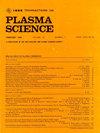Development of a 10–50-W Plasma Jet at 10 GHz
IF 1.3
4区 物理与天体物理
Q3 PHYSICS, FLUIDS & PLASMAS
引用次数: 0
Abstract
This article presents the design, development, and characterization of a plasma jet operating at 10 GHz, covering input power levels from 10 to 50 W. This work builds upon an established microwave plasma device development workflow, adapted for higher frequencies, and demonstrates its feasibility at four times the conventional frequency (2.45 GHz). Utilizing novel Hot-S measuring equipment spanning from 6 to 18 GHz, this article showcases the benefits of operating at higher frequencies. A compact plasma formation with minimal spatial expansion is observed that scales linearly with frequency above the plasma frequency, indicating improved efficiency and control over the plasma jet’s behavior. The length of the plasma increases by approximately 0.6 times relative to input power, while the width remains almost constant, suggesting optimal performance across the studied power range. Furthermore, temperature measurements using a ceramic cannula provide the temperature generated by the plasma.10ghz 10 - 50w等离子体射流的研制
本文介绍了工作在10ghz的等离子体射流的设计、开发和特性,其输入功率水平从10到50 W。这项工作建立在已建立的微波等离子体器件开发工作流程的基础上,适用于更高的频率,并证明了其在四倍于传统频率(2.45 GHz)下的可行性。利用6至18 GHz的新型Hot-S测量设备,本文展示了在更高频率下工作的好处。紧凑的等离子体形成与最小的空间膨胀被观察到,线性缩放频率高于等离子体频率,表明提高效率和控制等离子体射流的行为。等离子体的长度相对于输入功率增加了约0.6倍,而宽度几乎保持不变,表明在研究的功率范围内性能最佳。此外,使用陶瓷套管的温度测量提供了等离子体产生的温度。
本文章由计算机程序翻译,如有差异,请以英文原文为准。
求助全文
约1分钟内获得全文
求助全文
来源期刊

IEEE Transactions on Plasma Science
物理-物理:流体与等离子体
CiteScore
3.00
自引率
20.00%
发文量
538
审稿时长
3.8 months
期刊介绍:
The scope covers all aspects of the theory and application of plasma science. It includes the following areas: magnetohydrodynamics; thermionics and plasma diodes; basic plasma phenomena; gaseous electronics; microwave/plasma interaction; electron, ion, and plasma sources; space plasmas; intense electron and ion beams; laser-plasma interactions; plasma diagnostics; plasma chemistry and processing; solid-state plasmas; plasma heating; plasma for controlled fusion research; high energy density plasmas; industrial/commercial applications of plasma physics; plasma waves and instabilities; and high power microwave and submillimeter wave generation.
 求助内容:
求助内容: 应助结果提醒方式:
应助结果提醒方式:


